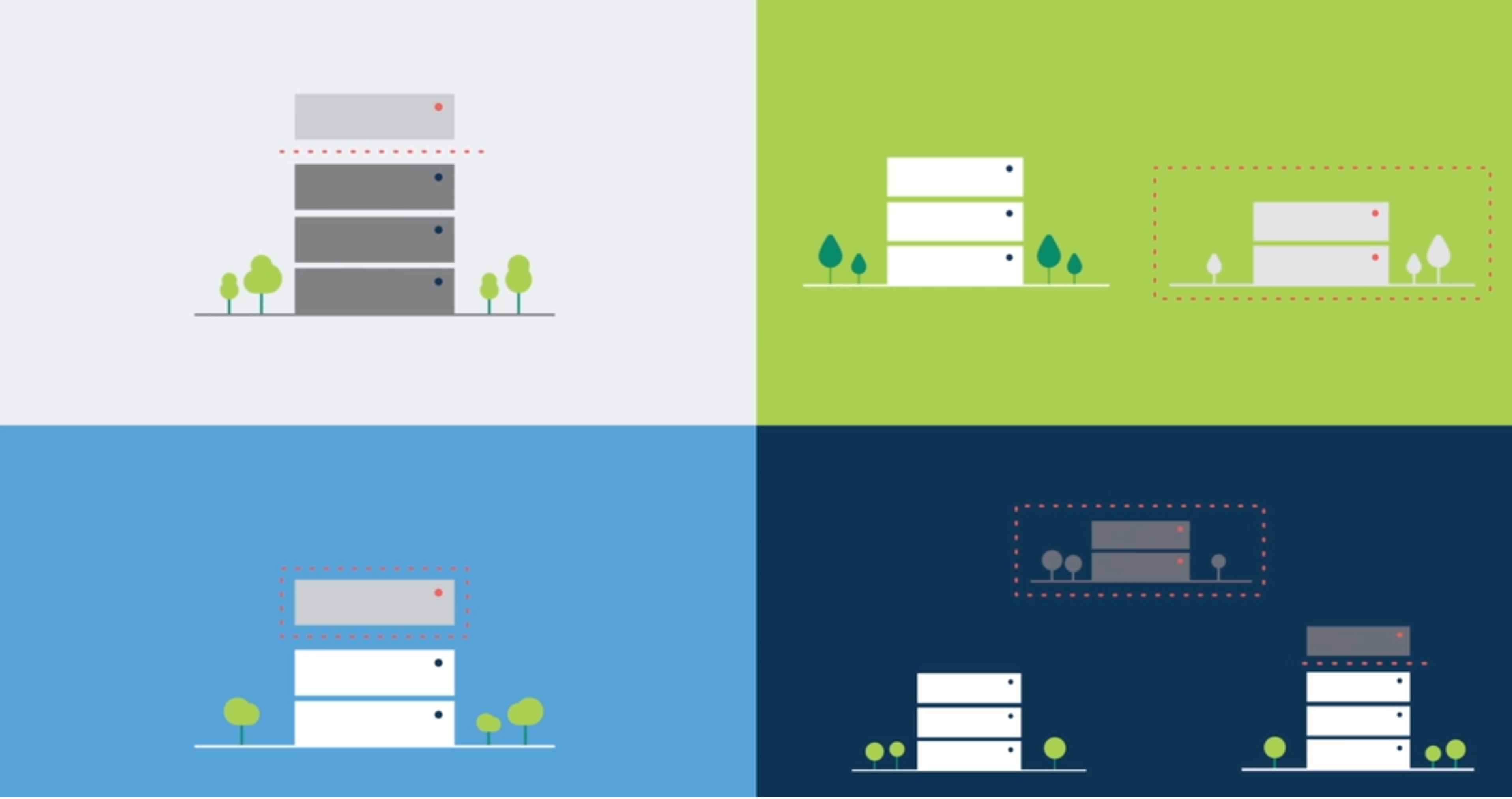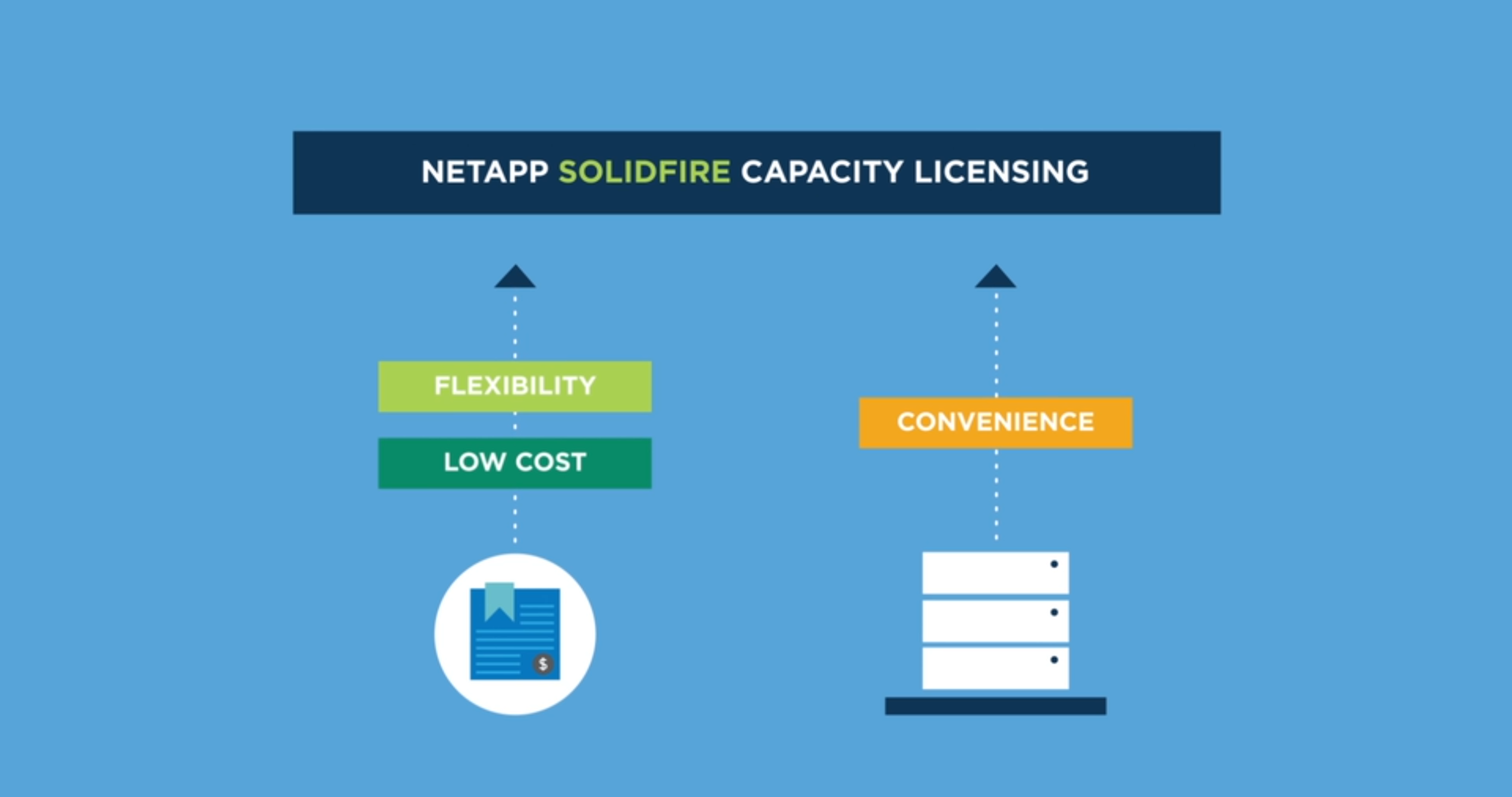
Flexible Purchasing Models for NetApp HCI and SolidFire
Term-Capacity and Node-Based Models Available to Support Business Needs
Enterprises prioritize flexibility, efficiency, and scale. How they purchase and use storage should be no different. With today's digital transformation, data growth, application acceleration, and innovative business practices, IT organizations are looking for new ways to purchase and consume their data storage. IT organizations need flexible purchase options when building their next-generation data center. When scaling the infrastructure, that flexibility comes from the option to purchase infrastructure up front or the option to decouple storage software from hardware.
Node-Based Model
- Capex model-pay up front
- Traditional purchase method
- Simple to predict and manage
With the node-based model, the costs of the hardware, software, and the first 3 years of support are included at the time of purchase. Support for year 4 and beyond is purchased as yearly contracts. This traditional, capital expenditure purchase model is simple to understand, predict, and manage. Organizations can simply plan their next data center purchase and, when ready, purchase the software and hardware outright.


Term-Capacity Model
- Capex model-software costs distributed over the life of the term
- Hardware and software costs are decoupled for additional flexibility
- Software costs are based on raw capacity
Get started with a lower entry price point under the term-capacity model. The hardware costs are the same at the time of purchase, but the software and support costs are distributed over time. Software costs are based on raw capacity (size of the drive times the number of drives in the node or cluster), making the software costs for this model easy to predict. Flexible refresh of hardware that is independent of software costs means that upgrade events are less costly. However, hardware and software capacity are coupled, meaning that scaling capacity up or down needs to be planned carefully.
Element Software
- Build your NetApp® HCI and SolidFire® cloud infrastructure with scale-out growth
- Leverage the Element API to automate your private cloud
- Consolidate diverse, rapidly changing applications with guaranteed performance
The customer-first approach of NetApp HCI and SolidFire offers flexible purchase options. Choose either the node-based model or the term-capacity model, based on your business needs, and enjoy the benefits of enterprise support and Element software.
Comparison of Node-Based and Term-Capacity Models
| Year 1 | Year 2 | Year 3 | Year 4 | Year 5 | Year 6 | Year 7 | 3 Year | 6 Year | 7 Year | ||
|---|---|---|---|---|---|---|---|---|---|---|---|
| Node-Based Model | HW | 110K | 110K | 110K | 110K | ||||||
| SW | 84K | 84K | 84K | 84K | |||||||
| Supt (Adv 4hr Replace) | 49K | 16K | 16K | 16K | 16K | 49K | 99K | 115K | |||
| TCO Cumulative | 243K | 243K | 243K | 260K | 276K | 293K | 309K | 243K | 293K | 309K | |
| Term-Capacity Model | HW | 110K | 110K | 110K | 110K | ||||||
| (3 Years Contract with 3 Years Ren) | SW | 58K | 58K | 58K | 58K | 116K | 174K | ||||
| Supt (Adv 4hr Replace) | 18K | 18K | 18K | 18K | 36K | 54K | |||||
| TCO | 186K | 186K | 186K | 262K | 262K | 262K | 337K | 186K | 262K | 337K | |
| % Delta | -24% | -24% | -24% | 1% | -5% | -11% | 9% | -24% | -11% | 9% |
Which Model Is Right for Your Business?
The above table is an example of how the pricing of these two models varies. For the first 3 years, the term-capacity model has a lower cost of ownership, but in years 4 and 7, this model has a higher TCO. Based on this example, the break-even point occurs at year 4, but it could be stretched due to support costs for 2 more years before the lifecycle of the term-based model becomes permanently more expensive than the perpetual by-node model.
Node-Based Model
Term-Capacity Model
Pros
- Familiar capex model
- Simple to understand and predict
- Flexible - Refresh HW independent of the SW cost
- On par $/GB for enterprise market
- Based on raw capacity - easy to understand
Cons
- Not flexible
- Strands capital
- Higher entry price
- Term-capacity approach is more complicated
- Loss of flexibility - HW capacity tied to SW capacity
Purchase Flexibility Yields Economic Benefits
Overall, the decision of how to purchase SolidFire or NetApp HCI is driven by the model that best fits an organization's overall business strategy. The two options are designed for dynamic, unpredictable, and rapidly growing environments like yours, giving you superior value with flexibility and cost savings for your enterprise. By decoupling market-leading software from the underlying hardware under the term-capacity model, NetApp offers a modern purchasing model that aligns with how storage is bought and consumed today. This model balances the flexibility of software-defined storage with the convenience of purpose-built appliances. Select the purchase method that makes the best sense for your enterprise; either way, you get the predictability, efficiency, and scalability of NetApp Element software.
Documentation
Download the Flexible Purchasing Models Sheet (PDF).

